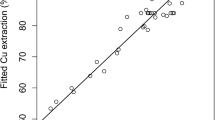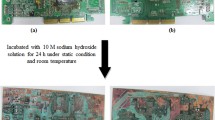Abstract
Despite attempts to enhance the recycling of waste printed circuit boards (WPCBs), the simultaneous recovery of major metals of WPCBs using an efficient approach is still a great challenge. This study mainly concerned with applying an effective statistical tool to optimize the recovery of metal content (i.e., Cu, Fe, Zn, Pb, Ni, Sn, and Al) embedded in WPCBs using a leaching agent without any additive or oxidative agent. Another target was to optimize a multi-response recovery process by minimizing time, energy, and acid consumption during the leaching. Effective parameters and their levels, including leaching time (20–60 min), temperature (25–45 °C), solid to liquid (S/L) ratio (1/8–1/20 g/ml), and acid molarity (1–2.7 M), were optimized. A well-established statistical approach (i.e., response surface methodology (RSM)) was applied to precisely quantify and interpret the effects. General optimum conditions for nine responses were introduced with the desirability of ≈ 85%. Finally, the solid residue of leaching was characterized and results showed the morphology, structure, and composition of the residue content (i.e., polymers and ceramics) remained the same after the leaching, indicating the neutral behavior of the leaching process on these two materials. Also, thermal behavior and phase analysis of the original WPCBs and leaching residue were compared and analyzed.

Graphical abstract






Similar content being viewed by others
References
Ahn JW, Chung DW, Lee K, Ahn J, Sohn HY (2011) Nitric acid leaching of base metals from waste PDP electrode scrap and recovery of ruthenium content from leached residues. Mater Trans 52:1063–1069
Akcil A, Erust C, Gahan CS, Ozgun M, Sahin M, Tuncuk A (2015) Precious metal recovery from waste printed circuit boards using cyanide and non-cyanide lixiviants - a review. Waste Manag 45:258–271
Anderson MJ, Whitcomb PJ (2015) DOE simplified: practical tools for effective experimentation, 3rd edn. CRC Press, Boca Raton
Assefi M, Davar F, Hadadzadeh H (2015) Green synthesis of nanosilica by thermal decomposition of pine cones and pine needles. Adv Powder Technol 26:1583–1589
Assefi M, Maroufi S, Mayyas M, Sahajwalla V (2018a) Recycling of Ni-Cd batteries by selective isolation and hydrothermal synthesis of porous NiO nanocuboid. J Environ Chem Eng 6:4671–4675
Assefi M, Maroufi S, Nekouei RK, Sahajwalla V (2018b) Selective recovery of indium from scrap LCD panels using macroporous resins. J Clean Prod 180:814–822
Birloaga I, De Michelis I, Ferella F, Buzatu M, Vegliò F (2013) Study on the influence of various factors in the hydrometallurgical processing of waste printed circuit boards for copper and gold recovery. Waste Manag 33:935–941
Castro LA, Martins AH (2009) Recovery of tin and copper by recycling of printed circuit boards from obsolete computers. Brazilian J Chem Eng 26:649–657
Chaurasia A, Singh KK, Mankhand TR (2013) Extraction of tin and copper by acid leaching of PCBs. Int J Met Eng 2:243–248
Das D, Chaudhuri MG (2016) Leaching kinetics of powdered PCB of mobile phones in HNO3 medium. Int J R Eng Tech 5:302–306
Djebaili K, Mekhalif Z, Boumaza A, Djelloul A (2015) XPS, FTIR, EDX, and XRD analysis of Al2O3 scales grown on PM2000 alloy. J Spec 2015:1–16
Evangelopoulos P, Kantarelis E, Yang W (2015) Investigation of the thermal decomposition of printed circuit boards (PCBs) via thermogravimetric analysis (TGA) and analytical pyrolysis (Py–GC/MS). J Anal Appl Pyrolysis 115:337–343
Faraji F, Golmohammadzadeh R, Rashchi F, Alimardani N (2018) Fungal bioleaching of WPCBs using Aspergillus niger: observation, optimization and kinetics. J Environ Manag 217:775–787
Fu K, Yue Q, Gao B, Sun Y, Zhu L (2013) Preparation, characterization and application of lignin-based activated carbon from black liquor lignin by steam activation. Chem Eng J 228:1074–1082
Ghosh B, Ghosh MK, Parhi P, Mukherjee PS, Mishra BK (2015) Waste printed circuit boards recycling: an extensive assessment of current status. J Clean Prod 94:5–19
Golmohammadzadeh R, Rashchi F, Vahidi E (2017) Recovery of lithium and cobalt from spent lithium-ion batteries using organic acids: process optimization and kinetic aspects. Waste Manag 64:244–254
Golmohammadzadeh R, Faraji F, Rashchi F (2018) Recovery of lithium and cobalt from spent lithium ion batteries (LIBs) using organic acids as leaching reagents: a review. Resour Conserv Recycl 136:418–435
Gomes AST, Souza LA, Yamane LH, Siman RR (2017) Quantification of E-waste: a case study in federal university of Espírito Santo, Brazil. Int J Environ Ecol Eng 11:171–179
Guo X, Liu J, Qin H, Liu Y, Tian Q, Li D (2015) Recovery of metal values from waste printed circuit boards using an alkali fusion-leaching-separation process. Hydrometallurgy 156:199–205
Heath JA, Jeffrey MI, Zhang HG, Rumball JA (2008) Anaerobic thiosulfate leaching: development of in situ gold leaching systems. Miner Eng 21:424–433
Huang K, Guo J, Xu Z (2009) Recycling of waste printed circuit boards: a review of current technologies and treatment status in China. J Hazard Mater 164:399–408
Ilyas S, Anwar MA, Niazi SB, Afzal Ghauri M (2007) Bioleaching of metals from electronic scrap by moderately thermophilic acidophilic bacteria. Hydrometallurgy 88:180–188
Imtiaz A, Farrukh MA, Khaleeq-ur-rahman M, Adnan R (2013) Micelle-assisted synthesis of Al2O3·CaO nanocatalyst: optical properties and their applications in photodegradation of 2, 4, 6-trinitrophenol. Sci World J 2013:1–11
Işıldar A, Rene ER, EDVan H, Lens PNL (2017) Two-step leaching of valuable metals from discarded printed circuit boards, and process optimization using response surface methodology. Adv Recycling Waste Manag 2:132–141
Kan Y, Yue Q, Gao B, Li Q (2015) Preparation of epoxy resin-based activated carbons from waste printed circuit boards by steam activation. Mater Lett 159:443–446
Kaya M (2017) Recovery of metals and nonmetals from waste printed circuit boards (PCBs) by physical recycling techniques. Energy Technol 2017:433–451
Kumar M, Lee J, Kim M, Jeong J, Yoo K (2014) Leaching of metals from waste printed circuit boards (WPCBs) using sulfuric and nitric acids. Environ Eng Manag J 13:2601–2607
Lee C-H, Chang S-L, Wang K-M, Wen L-C (2000) Management of scrap computer recycling in Taiwan. J Hazard Mater 73:209–220
Lee S, Kang K, Park JL, Hong M, Lee S, Cho S (2014) Electrolytic recovery of tin from printed circuit boards (PCBs) disassembled from waste liquid crystal displays (LCDs): selection of H2SiF6+H2SO4+H2O2 leaching solution over two-stage leaching in HNO3 and HCl. Curr Nanosci 10:104–107
Maroufi S, Nekouei RK, Assefi M, Sahajwalla V (2018) Waste-cleaning waste: synthesis of ZnO porous nano-sheets from batteries for dye degradation. Environ Sci Pollut Res 25:28594–28600
Mecucci A, Scott K (2002) Leaching and electrochemical recovery of copper, lead and tin from scrap printed circuit boards. J Chem Technol Biotechnol 77:449–457
Nekouei RK, Akhaghi R, Ravanbakhsh A, Tahmasebi R, Moghaddam AJ, Mahrouei M (2016) A study of the effect of two-stage tempering on mechanical properties of steel 30CrMnSi using analysis on response surface in design of experiment. Met Sci Heat Treat 57:694–701
Nekouei RK, Pahlevani F, Rajarao R, Golmohammadzadeh R, Sahajwalla V (2018a) Direct transformation of waste printed circuit boards to nano-structured powders through mechanical alloying. Mat Design 141:26–36
Nekouei RK, Pahlevani F, Rajarao R, Golmohammadzadeh R, Sahajwalla V (2018b) Two-step pre-processing enrichment of waste printed circuit boards (PCBs): mechanical milling and physical separation. J Clean Prod 184:1113–1124
Ning C, Lin CSK, Hui DCW, McKay G (2017) Waste printed circuit board (PCB) recycling techniques. Top Curr Chem 375:43
Shokri B, Firouzjah MA, Hosseini SI (2009) FTIR analysis of silicon dioxide thin film deposited by metal organic-based PECVD, pp 1–4
Torres R, Lapidus GT (2016) Copper leaching from electronic waste for the improvement of gold recycling. Waste Manag 57:131–139
Tran TN, Pham TVA, Le MLP, Nguyen TPT, Tran VM (2013) Synthesis of amorphous silica and sulfonic acid functionalized silica used as reinforced phase for polymer electrolyte membrane. Adv Nat Sci Nanoscie Nanotechnol 4:1–6
Valix OCM (2014) Thermogravimetric analysis and kinetic study of biochemically pretreated printed circuit board wastes. Waste Biomass Valoriz 2:211–222
Veith GM, Lupini AR, Dudney NJ (2009) Role of pH in the formation of structurally stable and catalytically active TiO2-supported gold catalysts. J Phys Chem C 113:269–280
Wach A, Drozdek M, Dudek B, Biazik M, Piotr Ł, Michalik M, Kus P (2015) Differences in catalytic activity of poly(vinylamine) introduced on surface of mesoporous SBA-15 by grafting from and grafting onto methods in knoevenagel condensation. J Phys Chem C 119:19954–19966
Wang L, Li Q, Li Y, Sun X, Li J, Shen J, Han W, Wang L (2017) A novel approach for recovery of metals from waste printed circuit boards and simultaneous removal of iron from steel pickling waste liquor by two-step hydrometallurgical method. Waste Manag 71:411–419
Won J, Lee AS, Yu S, Whan J (2018) En masse pyrolysis of flexible printed circuit board wastes quantitatively yielding environmental resources. J Hazard Mater 342:51–57
Yang H, Liu J, Yang J (2011) Leaching copper from shredded particles of waste printed circuit boards. J Hazard Mater 187:393–400
Yang C, Li J, Tan Q, Liu L, Dong Q (2017) Green process of metal recycling: coprocessing waste printed circuit boards and spent tin stripping solution. ACS Sustain Chem Eng 5:3524–3534
Zhao C, Zhang X, Shi L (2017) Catalytic pyrolysis characteristics of scrap printed circuit boards by TG-FTIR. Waste Manag 61:354–361
Acknowledgments
We thankfully acknowledge the technical support by Mark Wainwright Analytical Centre (MWAC) especially Solid State & Elemental Analysis Unit and Electron Microscopy Unit (EMU) at the University of New South Wales, Australia.
Funding
The financial support for this research was provided by the Australian Research Council through Laureate Fellowship FL140100215.
Author information
Authors and Affiliations
Corresponding author
Additional information
Responsible editor: Philippe Garrigues
Publisher’s note
Springer Nature remains neutral with regard to jurisdictional claims in published maps and institutional affiliations.
Highlights
- Applying a statistical tool (design of experiments) to optimize the removal of all heavy metals embedded in waste printed circuit boards.
- Minimizing processing time, energy, and consumed chemical agent without any additive or oxidative agent in order to reduce environmental impacts.
- Proving the stability of leaching residue (i.e., ceramic and polymer content) during the removal step of heavy metals.
Electronic supplementary material
ESM 1
(DOCX 3379 kb)
Rights and permissions
About this article
Cite this article
Khayyam Nekouei, R., Pahlevani, F., Golmohammadzadeh, R. et al. Recovery of heavy metals from waste printed circuit boards: statistical optimization of leaching and residue characterization. Environ Sci Pollut Res 26, 24417–24429 (2019). https://doi.org/10.1007/s11356-019-05596-y
Received:
Accepted:
Published:
Issue Date:
DOI: https://doi.org/10.1007/s11356-019-05596-y




